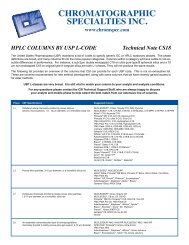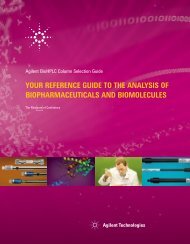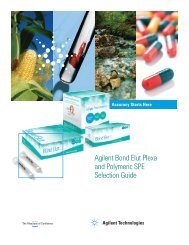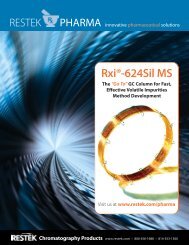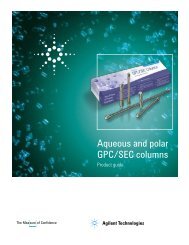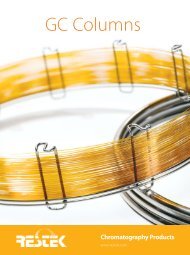Optimizing the Analysis of Volatile Organic Compounds
Optimizing the Analysis of Volatile Organic Compounds
Optimizing the Analysis of Volatile Organic Compounds
Create successful ePaper yourself
Turn your PDF publications into a flip-book with our unique Google optimized e-Paper software.
Similarly, <strong>the</strong> PTFE transfer line between <strong>the</strong> reactor and <strong>the</strong> conductivity cell requires fre-<br />
quent cleaning or replacement. Flushing <strong>the</strong> transfer line should remove most <strong>of</strong> <strong>the</strong> contamination.<br />
To do this, disconnect <strong>the</strong> line from <strong>the</strong> reaction tube and plug <strong>the</strong> drain line leading from<br />
<strong>the</strong> reaction cell. This will force propanol through <strong>the</strong> transfer line, flushing contamination out.<br />
If this does not improve response and peak shape, replace <strong>the</strong> transfer line (cat# 20121, page 27).<br />
Use only high-purity solvents in <strong>the</strong> ELCD (only HPLC-grade for halogen mode). The solvent<br />
intake line is equipped with a scrubber resin cartridge that removes contaminants from <strong>the</strong> solvent.<br />
To maintain solvent purity and a stable baseline, change this cartridge every six months.<br />
ELCD: Minimizing Peak Tailing: Peak tailing is a characteristic <strong>of</strong> <strong>the</strong> ELCD – <strong>the</strong> key to<br />
successful ELCD operation is regular maintenance to minimize <strong>the</strong> tailing. Most tailing<br />
problems are caused by contamination or leaks in <strong>the</strong> system. Peak tailing also can be<br />
caused by contamination in <strong>the</strong> PTFE<br />
Contaminated conductivity cell<br />
Contaminated reaction tube<br />
Contaminated resin cartridge<br />
transfer line from <strong>the</strong> reaction tube to <strong>the</strong> conductivi-<br />
ty cell. Table III lists factors that can contribute to tailing peaks. Reaction tube deterioration<br />
can be due to water and/or oxygen corroding <strong>the</strong> tube surface over time, or to carbon<br />
deposits left by <strong>the</strong> organic solvent. In purge and trap applications, water management can<br />
help slow this corrosion.<br />
Poor responses for brominated compounds indicate active sites in <strong>the</strong> pathway. Isolate <strong>the</strong><br />
purge and trap system by making a manual injection. If responses for brominated compounds<br />
still are poor, <strong>the</strong> reaction tube probably is deteriorating. A combination <strong>of</strong> tailing<br />
peaks and poor responses for brominated compounds also is an indication that <strong>the</strong> reaction<br />
tube must be replaced. Maintain detailed notes on instrument maintenance to minimize troubleshooting<br />
problems in <strong>the</strong> future.<br />
ELCD performance also depends on <strong>the</strong> internal volume <strong>of</strong> <strong>the</strong> conductivity cell. Older<br />
ELCDs have larger cell volumes that cause more tailing. Smaller cells in newer ELCDs significantly<br />
reduce peak tailing.<br />
Table III.<br />
Common causes <strong>of</strong> excessive peak tailing from an ELCD.<br />
Low makeup gas flow<br />
Low propanol flow<br />
Low reaction gas flow (hydrogen)<br />
Contaminated PTFE transfer line Low reaction temperature (below 850°C)<br />
Dead volume between detectors in series<br />
Leak at <strong>the</strong> base <strong>of</strong> <strong>the</strong> reaction tube<br />
Unpure gas (carrier / makeup / reaction)<br />
Replacement Nickel Reaction Tubes<br />
Pretreated for maximum sensitivity.<br />
Quality-controlled for reliability.<br />
Available for different models.<br />
To replace <strong>the</strong>se instrument part numbers:<br />
Order <strong>the</strong>se<br />
Restek part<br />
numbers:<br />
ELCD Model # Tremetrics Varian PerkinElmer Shimadzu O.I. Analytical qty. cat.#<br />
Hall 700A 115439-0003 00-996724-14 0330-2675 — — 2-pk. 21580<br />
Hall 1000 117459-0003 00-997625-12 N660-1072 220-90435-00 — 2-pk. 21581<br />
O.I. 4420 — — — — 183780 2-pk. 21582<br />
Figure 27.<br />
ELCD reactor removed from detector<br />
assembly, reaction tube exposed.<br />
Nickel<br />
Reaction<br />
Tube<br />
Always<br />
Check Here<br />
for Leaks.<br />
29<br />
www.restekcorp.com





